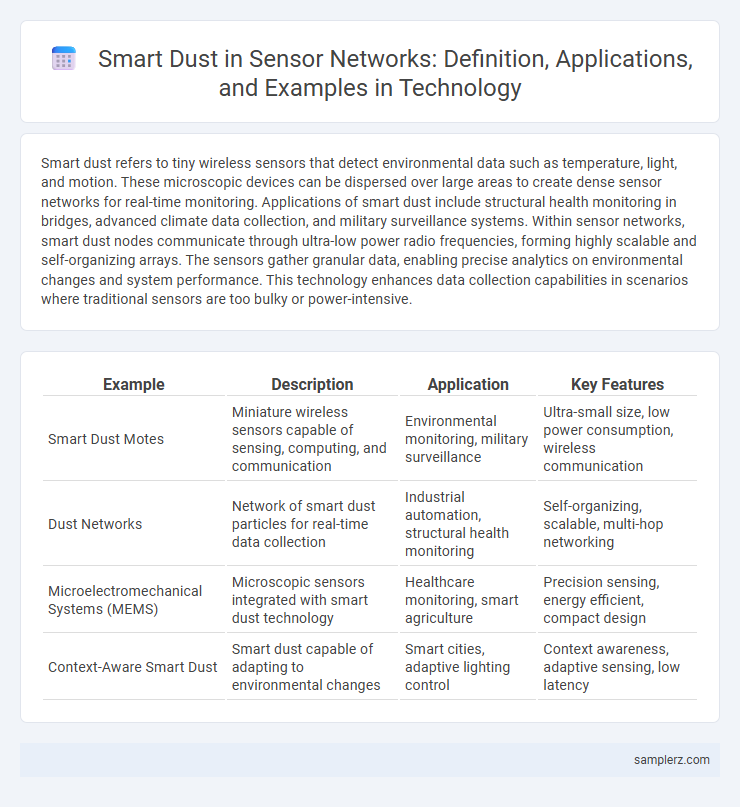Smart dust refers to tiny wireless sensors that detect environmental data such as temperature, light, and motion. These microscopic devices can be dispersed over large areas to create dense sensor networks for real-time monitoring. Applications of smart dust include structural health monitoring in bridges, advanced climate data collection, and military surveillance systems. Within sensor networks, smart dust nodes communicate through ultra-low power radio frequencies, forming highly scalable and self-organizing arrays. The sensors gather granular data, enabling precise analytics on environmental changes and system performance. This technology enhances data collection capabilities in scenarios where traditional sensors are too bulky or power-intensive.
Table of Comparison
| Example | Description | Application | Key Features |
|---|---|---|---|
| Smart Dust Motes | Miniature wireless sensors capable of sensing, computing, and communication | Environmental monitoring, military surveillance | Ultra-small size, low power consumption, wireless communication |
| Dust Networks | Network of smart dust particles for real-time data collection | Industrial automation, structural health monitoring | Self-organizing, scalable, multi-hop networking |
| Microelectromechanical Systems (MEMS) | Microscopic sensors integrated with smart dust technology | Healthcare monitoring, smart agriculture | Precision sensing, energy efficient, compact design |
| Context-Aware Smart Dust | Smart dust capable of adapting to environmental changes | Smart cities, adaptive lighting control | Context awareness, adaptive sensing, low latency |
Real-Time Environmental Monitoring with Smart Dust
Smart dust sensors enable real-time environmental monitoring by deploying minuscule, wireless microelectromechanical systems (MEMS) that continuously collect data on temperature, humidity, and pollutant levels. These sensor networks provide granular spatial and temporal insights, facilitating rapid response to environmental changes and improving ecosystem management. Integration with cloud computing platforms enhances data analysis and predictive modeling, optimizing decision-making processes in smart city applications.
Smart Dust Applications in Industrial IoT Sensor Networks
Smart dust technology enables wireless sensor networks by deploying tiny, low-power sensors capable of monitoring environmental conditions in real-time. In Industrial IoT sensor networks, smart dust facilitates enhanced asset tracking, predictive maintenance, and process optimization through dense sensor deployment in manufacturing plants. These sensors improve operational efficiency by providing granular data on temperature, humidity, vibration, and chemical presence, enabling proactive decision-making and reducing downtime.
Smart Dust for Precision Agriculture Sensors
Smart Dust technology in precision agriculture enables the deployment of tiny, wireless sensor nodes that monitor soil moisture, temperature, and crop health in real time. These miniature sensors collect and transmit granular environmental data, allowing farmers to optimize irrigation, fertilizer application, and pest control with high accuracy. The integration of Smart Dust in sensor networks enhances crop yield, conserves water, and reduces resource wastage through precise, data-driven decision-making.
Healthcare Sensor Networks Enhanced by Smart Dust
Healthcare sensor networks enhanced by smart dust enable real-time monitoring of vital signs and environmental conditions with unprecedented precision and granularity. These microscopic sensors, equipped with wireless communication capabilities, facilitate continuous patient tracking in hospitals and remote care settings, improving early diagnosis and personalized treatment. Integration of smart dust in healthcare sensor networks optimizes data collection, reduces latency, and supports proactive health management through seamless and scalable deployment.
Structural Health Monitoring Using Smart Dust Sensors
Smart dust sensors embedded in sensor networks enable real-time structural health monitoring by detecting micro-vibrations, temperature changes, and stress variations in critical infrastructure. These ultra-small, wireless devices provide continuous data to improve safety and maintenance efficiency for bridges, buildings, and aircraft. Integrating smart dust enhances predictive analytics, reducing the risk of sudden failures and lowering operational costs.
Smart Dust in Urban Infrastructure Sensor Networks
Smart Dust technology in urban infrastructure sensor networks enables real-time monitoring of environmental conditions, structural health, and traffic flow through miniature, wireless sensors dispersed throughout cities. These microelectromechanical systems (MEMS) collect and transmit data on air quality, noise pollution, and infrastructure integrity, enhancing urban planning and maintenance. Deployment of Smart Dust in smart cities improves resource management, reduces operational costs, and supports sustainable development by providing granular, actionable insights.
Military Surveillance Systems Leveraging Smart Dust Sensors
Military surveillance systems leverage smart dust sensors to enable real-time monitoring of vast battlefields through networks of minuscule, wireless motes capable of detecting movement, sound, and chemical signatures. These sensors provide discreet, persistent situational awareness by forming dense sensor networks that relay critical data to command centers, enhancing threat detection and reconnaissance accuracy. Smart dust's ability to operate autonomously in harsh environments offers strategic advantages for intelligence gathering and battlefield communication.
Data Collection in Remote Locations with Smart Dust
Smart dust technology enables precise data collection in remote locations through networks of tiny, wireless sensors that monitor environmental conditions such as temperature, humidity, and chemical presence. These sensors operate autonomously, transmitting real-time data to centralized systems for analysis without the need for manual intervention. Deploying smart dust in difficult-to-access areas enhances monitoring capabilities in agriculture, wildlife tracking, and environmental research.
Smart Dust for Disaster Detection and Early Warning Sensors
Smart Dust technology enhances sensor networks by deploying tiny, wireless microelectromechanical sensors for real-time disaster detection and early warning systems. These sensors detect environmental changes such as seismic activity, chemical leaks, or temperature fluctuations, enabling rapid hazard identification. The integration of Smart Dust in disaster management improves situational awareness and accelerates response times, mitigating the impact of natural and industrial catastrophes.
Energy-Efficient Sensor Networks Enabled by Smart Dust
Smart dust technology revolutionizes energy-efficient sensor networks through ultra-miniature, low-power sensors capable of autonomous data collection and wireless communication. These microelectromechanical systems (MEMS) integrate sensors, processing units, and communication modules on a microscopic scale, dramatically reducing energy consumption and extending network lifespan. Deploying smart dust nodes enables pervasive environmental monitoring and real-time data aggregation while maintaining minimal power usage, essential for sustainable sensor network operations.

example of smart dust in sensor network Infographic
 samplerz.com
samplerz.com